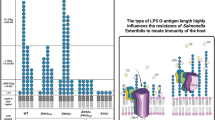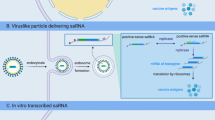Abstract
IN the interaction between macrophages and intracellular parasites, microbial components which prevent phagosome–lysosome fusion1,2 have a decisive role. The resistance to faculative intracellular parasite Listeria monocytogenes is a form of cell-mediated immunity3, as it can be passively transferred with viable lymphoid cells4. Resistance to listeria infection can be induced by sublethal numbers of viable listeria5,6. Induction of resistance by non-viable listeria, however, is effective only after repeated injections of listeria preparations in combination with lipopolysaccharides7. Lipopolysaccharide is cytotoxic against macro-phages8,9, suggesting that the difference in processing of viable and dead microorganisms by macrophages might explain the induction of resistance by vaccine of live and not of dead bacteria. Impairing macrophage activity might result in a processing of dead listeria advantageous for the induction of resistance. We show here that killed L. monocytogenes vaccine becomes protective when the polyanions dextran sulphate (DS 500, molecular weight 500,000, Serva) and suramin (Bayer) are added. These polyanions are known to inhibit phagosome–lysosome fusion in macrophages2,10. Moreover, dextran sulphate is a potent adjuvant for both humoral11 and cell-mediated responses12. The latter might be particularly important in view of the requirement of cell-mediated immunity for resistance to listeria3.
Similar content being viewed by others
References
Goren, M. B., Brokl, O. & Schaefer, W. B. Infect. Immun. 9, 142–149 (1974).
Goren, M. B., Hart, P. D'Arcy, Young, M. R. & Armstrong, J. A. Proc. natn. Acad. Sci. U.S.A. 73, 2510–2514 (1976).
Mackaness, M. B. J. exp. Med. 116, 381–406 (1962).
Mackaness, M. B. J. exp. Med. 129, 973–992 (1969).
Hasenclever, H. F. & Karakawa, W. W. J. Bact. 74, 584–586 (1957).
Kerckhaert, J. A. M., Hofhuis, J. M. A. & Willers, J. M. N. Immunology 32, 1027–1032 (1977).
Rodriguez, G. E., McClatchy, J. K. & Campbell, P. A. Infect. Immun. 10, 1163–1169 (1974).
Kessel, R. W. I. & Braun, W. Aust. J. exp. Biol. med. Sci. 43, 511–522 (1965).
Bradley, S. G. & Watson, D. W. Proc. Soc. exp. Biol. 117, 570–572 (1964).
Hart, P. D'Arcy & Young, M. R. Nature 256, 47–49 (1975).
Diamantstein, T., Wagner, B., Beyse, I., Odenwald, M. V. & Schulz, G. Eur. J. Immun. 1, 340–343 (1971).
McCarthy, R. E., Arnold, L. W. & Babcock, G. F. Immunology 32, 963–974 (1977).
Armstrong, J. A. & Hart, P. D'Arcy J. exp. Med. 134, 713–740 (1971).
Hahn, H. Infect. Immun. 10, 1105–1109 (1974).
Hahn, H. & Bierther, M. Infect. Immun. 10, 1110–1119 (1974).
Author information
Authors and Affiliations
Rights and permissions
About this article
Cite this article
MEER, C., HOFHUIS, F. & WILLERS, J. Killed Listeria monocytogenes vaccine becomes protective on addition of polyanions. Nature 269, 594–595 (1977). https://doi.org/10.1038/269594a0
Received:
Accepted:
Published:
Issue Date:
DOI: https://doi.org/10.1038/269594a0
- Springer Nature Limited
This article is cited by
-
Impaired macrophage functions as a possible basis of immunomodification by microbial agents, tilorone and dimethyldioctadecylammonium bromide
Antonie van Leeuwenhoek (1983)
-
Failure of killed Listeria monocytogenes vaccine to produce protective immunity
Nature (1982)
-
Killed Listeria monocytogenes vaccine is protective in C3H/HeJ mice without addition of adjuvants
Nature (1980)
-
Regulation of the immune response by macrophages
Antonie van Leeuwenhoek (1979)
-
The effect of Dextransulfate 500 on the pathogenesis of herpes simplex virus infections in weanling mice
Archives of Virology (1978)





